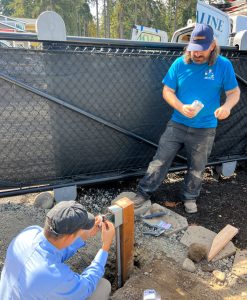
Troubleshooting and electrical repairs by a qualified electrician involve a systematic and professional approach to identifying and fixing electrical problems.
Here are the steps that our team of electricians typically follows:
- Safety Precautions: Electricians always prioritize safety. They start by turning off the power to the affected circuit or equipment to ensure that there’s no risk of electrical shock. They may also use personal protective equipment (PPE) as needed.
- Assessment: The electrician assesses the problem by discussing it with the customer or reviewing any available documentation to understand the issue’s symptoms and potential causes.
- Visual Inspection: A visual inspection is conducted to check for any obvious issues such as loose connections, damaged wires, or burnt components. They look for signs of wear and tear.
- Use of Test Instruments: Electricians use a range of test instruments like multimeters, voltage testers, circuit analyzers, and clamp meters to measure voltage, current, resistance, and other electrical parameters. These instruments help them pinpoint the problem.
- Isolation: They may isolate the issue by disconnecting and testing individual components or sections of the electrical system to determine the exact location of the problem.
- Review of Schematics: If available, electricians refer to electrical schematics or wiring diagrams to understand the circuit’s design and connections. This can be especially helpful for complex systems.
- Power Verification: They check if power is reaching the affected components and if the power source is functioning correctly. This may involve measuring voltage at various points in the circuit.
- Continuity and Resistance Testing: Electricians check for continuity to ensure that wires and connections are intact. They may also measure resistance to identify issues like open circuits or high resistance.
- Short Circuit Identification: They look for short circuits that can cause unwanted connections between wires or components. Shorts can lead to electrical problems and may require insulation or component replacement.
- Component Replacement or Repair: Once the problem is identified, electricians proceed to repair or replace the faulty components or wires. They ensure that they use compatible replacement parts and follow manufacturer guidelines.
- Reassembly and Testing: After making the necessary repairs, electricians reassemble the system and test it to ensure the issue is resolved. They carefully check that all components are correctly connected and secured.
- Documentation: Electricians maintain accurate records of their work, including a description of the problem, the steps taken for troubleshooting and repair, and details of any parts replaced. Documentation is important for record-keeping and future reference.
- Safety and Functionality Verification: Before returning the system to service, electricians verify that it is safe and functions correctly. They conduct a thorough testing and inspection to confirm that the problem has been resolved.
For any electrical trouble shooting and electrical repair work in the greater Seattle area, call us today at (360) 515-4779.

